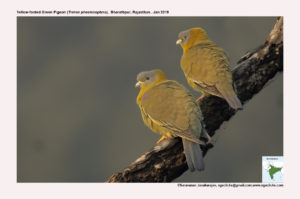Yellow-footed Green Pigeon

Yellow-footed Green Pigeon Treron phoenicopterus
Etymology:
- Treron : Greek word for Pigeon
- Phoenicopterus : Greek word phoinix –crimson; pteros–winged {Red winged}
Vernacular Names: Hindi: Pili Tang kaHarial, Pun: Harial, Ben: Harial, Ass: Haitha, Borhaita, Cachar: Daorepgadeba, Naga: Inruigu, Guj: Hariyal, Mar: Pisawa, PivalyapayachaHariyal/ Haroli, Ta: Pachchaipura, Te: Pachcha polka/guvva, Sinh: Bata goya
Distribution in India:Widespread resident except for some parts of North West and North Himalayas.
Description: Size of 30-33 cm; Wt. of 226–248 g. It has top of head, nape and cheeks as bluish grey, washed with yellowish green on forehead; throat yellowish green becoming bright mustard-yellow on neck and breast and darker mustard-yellow on hind neck; pale grey band across mantle, separating dark yellow hind neck from yellowish-green upperparts; pale mauve patch on shoulder of wing; primaries and secondaries blackish, edged light yellow; broader yellow edges to greyish-green greater wing-coverts; basal half of tail feathers washed yellowish green, rest slate-grey; underparts except breast pale bluish grey washed yellowish green, and flank feathers edged whitish or yellow; tibia and upper tarsus yellow; under tail-coverts purplish chestnut with broad buffy tips; under tail blackish on basal half, silvery grey distally; orbital skin pale greenish or pale grey; bill greyish white, pale grey or pale greenish, darker at base; legs and feet bright yellow or yellowish orange. The female is similar to male but duller, with smaller mauve shoulder patch.The juvenile is duller and paler than adult, with little or no mauve on shoulder. The Nominate race is found all over India except east; race chlorigaster( East of India ) has yellow legs, most of underparts greenish yellow, and little or no greenish yellow on forehead or tail.
Habitat: It is found in Forest, scrubland, parks and gardens in lowlands and foothills. Prefers area with Pipal tree.
Food Habits:
It is Frugivorous, feeding on a variety of drupes, berries and wild figs. Figs are particularly important part of the diet. Also feeds on buds, shoots and cultivated grain. It will come to the ground to visit salt-licks.
Breeding Habits: They breed in April-Aug. The nest is a relatively slight platform of twigs, grasses, leaves and feathers in a tree or shrub. The nest is constructed by both sexes over period of 6–7 days; two or more pairs will often nest in close proximity, sometimes in the same tree; nest often placed in a tree that holds a Black Drongo (Dicrurus macrocercus) nest, presumably to gain protection from the vigilance of that aggressive species. They lay two white eggs; incubation period is 21 days, by both sexes (mainly the female), with a fledging period of 22 days.